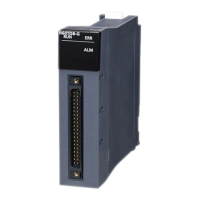134
9 LABEL ACCESS
9.1 Data to be Specified in Commands
■Data communication in ASCII code
Convert the numerical value to 4-digit ASCII code (hexadecimal), and send it from the upper digits.
■Data communication in binary code
Send 2-byte
*1
numerical values from lower byte (L: bits 0 to 7).
*1 For C24, the additional code may be added. (Page 35 Additional code (10H))
Setting example
■Batch read and write of array
For the bit specification, specify the number of bits to be accessed.
• Unit specification: Bit
• Label: Bit type 3 points
• Array data length: 1 bit Number of array element (3) = 3 bits
For byte specification, specify the data length of the label to be accessed in byte unit.
• Unit specification: Byte
• Label: Word type 5 points
• Array data length: 2 bytes (5) = 10 bytes
■Random read and write
For bit type, data length will be 2 (fixed value).
• Label: Bit type 1 point
• Data length: 2 (fixed)
The character string type [Unicode] will be 2 bytes per one character of UTF-16 code.
• Label: Character string type [Unicode] one point
• "Data Length of Character String Data Type" of an Engineering tool: 32
• Data length: Number of characters (32 + 1) Data length per one character string (2) = 66 (42H)
ASCII code Binary code
ASCII code Binary code
ASCII code Binary code
ASCII code Binary code

